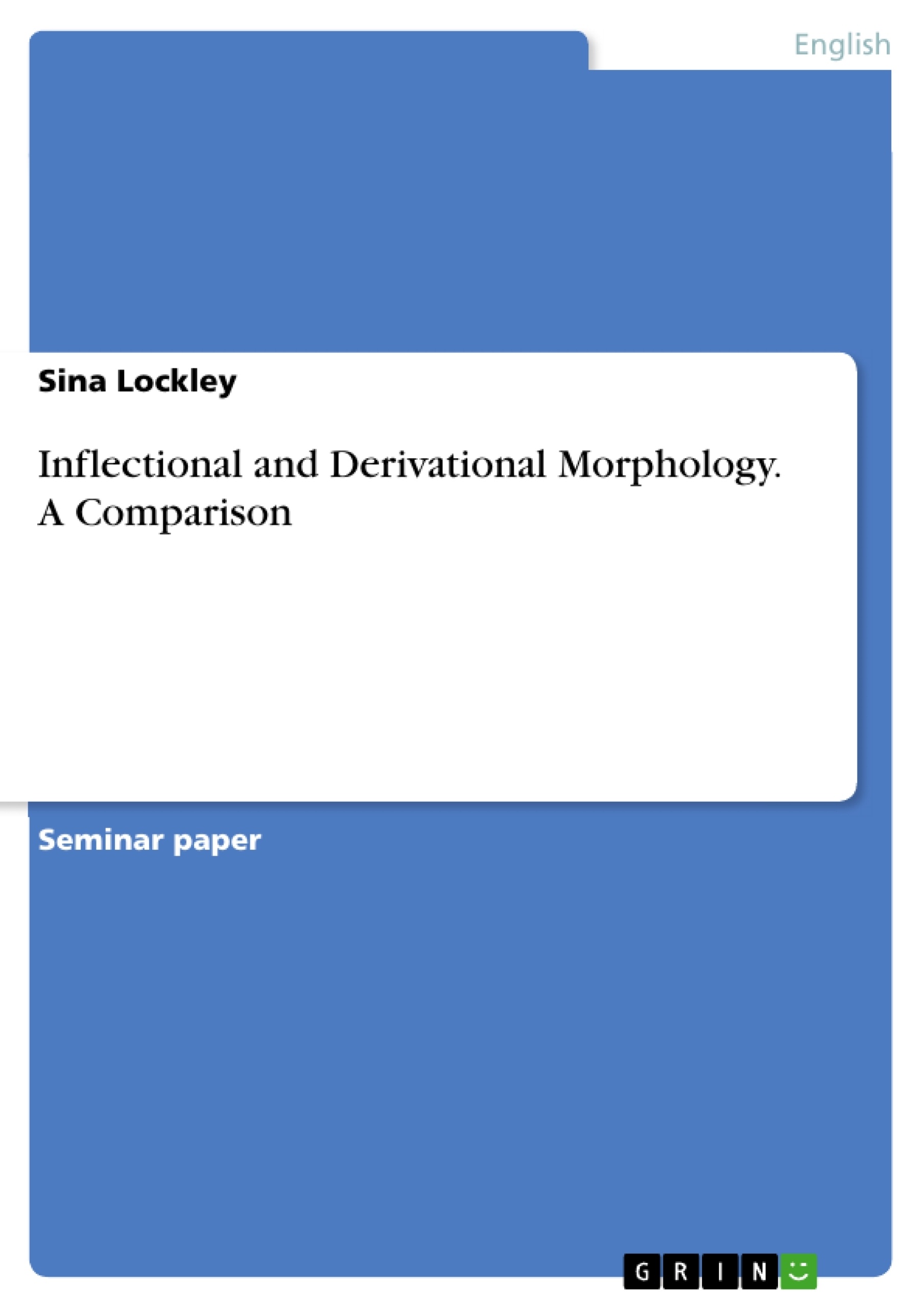My term paper contains first of a section about Inflectional Morphology in which I would like to explain how it is used with nouns, verbs and adjectives and what exceptions and special cases there are. Secondly I want to do the same for Derivational Morphology and then compare both to underline the differences between the two. At the end in my conclusion I would like to sum up the comparison and show why I think Derivational Morphology produces a wider range of new words then Inflectional Morphology does.
Table of Contents
- 1. Introduction
- 2. Inflectional Morphology
- 2.1. Definition of Inflectional Morphology
- 2.2. Inflectional Morphology on Nouns
- 2.3. Inflectional Morphology on Verbs
- 2.4. Inflectional Morphology on Adjectives
- 3. Derivational Morphology
- 3.1. Definition of Derivational Morphology
- 3.2. Change of Nouns
- 3.3. Change of Verbs
- 3.4. Change of Adjectives
- 4. Comparison of Inflectional and Derivational Morphology
- 5. Conclusion
- 6. References
Objectives and Key Themes
This term paper aims to compare and contrast inflectional and derivational morphology, demonstrating the differences in their function and the range of new lexemes they produce. The author argues that derivational morphology offers a far greater potential for word creation than inflectional morphology.
- Definition and differentiation of inflectional and derivational morphology.
- Analysis of inflectional morphology applied to nouns, verbs, and adjectives.
- Analysis of derivational morphology applied to nouns, verbs, and adjectives.
- Comparison of the scope and limitations of both morphological processes.
- Demonstration of derivational morphology's wider range of word creation.
Chapter Summaries
1. Introduction: This introductory chapter establishes the paper's focus on inflectional and derivational morphology. It highlights the complexity of morphology and explains the importance of understanding how word structure contributes to precise communication. The author introduces the core argument: derivational morphology has a significantly wider capacity for creating new words than inflectional morphology, a claim that will be explored and supported throughout the paper.
2. Inflectional Morphology: This chapter defines inflectional morphology as the modification of existing lexemes to express grammatical features without changing the word class. The chapter provides examples illustrating inflection in nouns (number), verbs (tense, person), and adjectives (comparative and superlative forms). The discussion includes an exploration of allomorphs (e.g., different plural endings for nouns) and zero morphemes, where grammatical distinctions are made without overt changes to the word form. The chapter emphasizes that inflectional morphemes typically don't require separate dictionary entries due to their predictable nature and grammatical function.
3. Derivational Morphology: This section offers a definition of derivational morphology, which involves using affixes to create new words with altered meanings or word classes. It uses examples to illustrate how derivational affixes change the meaning and/or part of speech of the base word, contrasting this with the purely grammatical changes brought about by inflectional morphology. The chapter illustrates these processes with examples across nouns, verbs, and adjectives, demonstrating the potential for significant semantic and grammatical shifts through the addition of prefixes and suffixes.
Keywords
Inflectional morphology, derivational morphology, morphemes, allomorphs, word formation, lexemes, affixes, prefixes, suffixes, grammatical features, semantic change, word class, nouns, verbs, adjectives, zero morpheme.
Frequently Asked Questions: A Comprehensive Language Preview
What is the main topic of this language preview?
This preview comprehensively covers inflectional and derivational morphology, comparing and contrasting their functions and word-creation capabilities. It argues that derivational morphology offers significantly greater potential for new word formation.
What topics are covered in the Table of Contents?
The Table of Contents includes an introduction, chapters dedicated to inflectional and derivational morphology (each further subdivided into sections examining nouns, verbs, and adjectives), a comparison of both morphological types, a conclusion, and a list of references.
What are the key objectives and themes of the preview?
The main objectives are to define and differentiate inflectional and derivational morphology, analyze their applications to nouns, verbs, and adjectives, and compare their scope and limitations. The central theme is demonstrating the superior word-creation potential of derivational morphology compared to inflectional morphology.
What is the definition of inflectional morphology as explained in the preview?
Inflectional morphology modifies existing words to show grammatical features (like tense or number) without changing the word's class. It uses examples illustrating inflection in nouns, verbs, and adjectives, including the concept of allomorphs and zero morphemes.
What is the definition of derivational morphology as presented in the preview?
Derivational morphology uses affixes to create new words with changed meanings or word classes. It alters the base word's meaning and/or part of speech, unlike inflectional morphology which only alters grammatical features.
How does the preview compare inflectional and derivational morphology?
The preview directly compares the two types, highlighting that inflectional morphology primarily deals with grammatical functions and has limited word-creation capacity, while derivational morphology creates entirely new words with altered meanings or grammatical classifications.
What examples are used to illustrate inflectional and derivational morphology?
Examples are provided for both noun, verb, and adjective inflection (number, tense, person, comparative/superlative forms) and derivation (prefixes and suffixes altering meaning and/or word class).
What are the key words associated with this language preview?
Key words include inflectional morphology, derivational morphology, morphemes, allomorphs, word formation, lexemes, affixes, prefixes, suffixes, grammatical features, semantic change, word class, nouns, verbs, adjectives, and zero morpheme.
What is the conclusion of the preview?
The conclusion summarizes the findings, reinforcing the argument that derivational morphology significantly surpasses inflectional morphology in its capacity for generating new words. (Specific details of the conclusion are not provided in the preview's summary).
Where can I find further information or references?
The preview mentions a "References" section, but the actual references are not included in this preview.
- Quote paper
- Sina Lockley (Author), 2014, Inflectional and Derivational Morphology. A Comparison, Munich, GRIN Verlag, https://www.grin.com/document/285108




